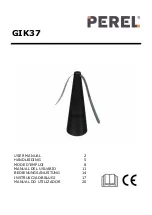
19
18
EXposiNg ThE gLENoiD
The forked retractor should be placed under the
inferior glenoid labrum to move the humerus distally or
posteriorly, depending on the approach taken (Figure 20).
When exposing the glenoid, it is critical to note the
presence of the axillary nerve and protect it at all times.
Excise the biceps remnant and entire labrum. Release the
entire capsule from around the glenoid.
in certain cases, the capsule may have to be excised
depending on the extent of any contractures and the
adequacy of exposure. Also, the origin of the triceps
long head may be incised from the infraglenoid tubercle.
Bluntly (finger or elevator) dissect in a circumferential
manner from the base of the coracoid process to well
beyond the most inferior aspect of the glenoid.
it is essential to palpate the following bony scapular
orientation points: the base of the coracoid process,
the inferior part of the glenoid neck and when possible,
infraglenoid tubercle and lateral border of the scapula.
Retractors should be placed so that the entire glenoid face
is in clear view to aid accurate placement of the guide pin.
Glenoid Preparation
Remove any remnants of labrum from the glenoid. Then
remove all articular cartilage from the glenoid face using a
large straight curette. in addition, any osteophytes present
may also have to be removed to determine the bony
anatomy.
Figure 20















































